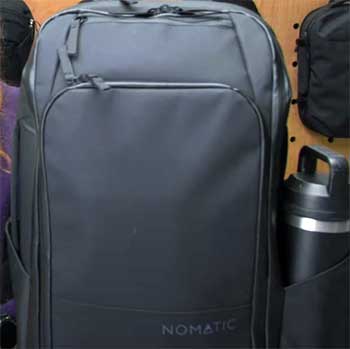With the rise in popularity of smart and innovative travel gear, luggage brands like Nomatic and Away have quickly become favorites among frequent travelers. Both offer sleek, minimalist suitcases packed with clever features to optimize packing efficiency and ease of travel.
But which one reigns supreme? Here’s an in-depth comparison of Nomatic Vs. Away luggage.
A Brief Comparison Table Of Nomatic And Away Luggage:
| Feature | Nomatic | Away |
| Material | Makrolon Polycarbonate | Polycarbonate |
| Lock Type | TSA-approved Combination | TSA-approved Combination |
| Wheels | Double Spinner | Double Spinner |
| Interior Customizability | Excellent – fully modular | Medium – some dividers |
| Compression | Side straps | Integrated compression board |
| Charging Capability | No | Yes, charger pack addon |
| Laundry Bag | Yes | Yes |
| Front Quick Access | Yes | Yes |
| Color and Design Options | Limited – 3 colors | Extensive – collaborations and colors |
| Price | $245 – $395 | $225 – $295 |
| Expansion | Up to 40% | Up to 15% |
Overview Of Nomatic
Founded in 2014 after a successful Kickstarter campaign, Nomatic specializes in functional, modular luggage and bags. Their signature suitcases have a sleek, minimalist design with premium materials like 100% Makrolon Polycarbonate shells, YKK zippers, and lined interiors.

Nomatic is best known for its innovative modular design that allows custom configuration of the interior. Removable dividers, tie-down straps, and multiple compartments allow you to perfectly organize clothes, gear, and other items.
The suitcases also feature expansion capability, going from a standard carry-on size to a large checked bag size.
Other key features of Nomatic luggage:
- TSA approved combination lock
- 360 degree spinner wheels
- Laundry bag included
- Front quick-access pocket
- Compression straps for minimizing size
- Water resistant material
Nomatic offers their signature hardcase luggage in three sizes: the Travel Bag, Travel Pack, and Check-In Bag. Prices range from $245 to $395. They also offer a selection of backpacks, duffel bags, and accessories.
Also Read: Comparison Between Samsonite And Calpak Luggage
Overview Of Away
Founded in 2015, Away quickly made a name for itself as a trendy millennial brand offering sleek, Instagrammable luggage. Their bestselling suitcases have a fashionable, minimalist design constructed from durable polycarbonate.
The patented compressions system allows you to compress the case uniformly up to 15%, maximizing packing capacity. The interiors feature a lightweight compression board and clip system to hold contents in place.
Other notable features of Away luggage:

- TSA approved combination lock
- 360 degree spinner wheels
- Removable laundry bag
- Lined interior with mesh compartments
- Front exterior pocket
- Charger pack with USB port for on-the-go device charging
Away offers their signature suitcases in four sizes: The Carry-On, The Bigger Carry-On, The Medium, and The Large. Prices range from $225 to $295. They also offer limited edition collections and a range of accessories and bags beyond suitcases.
Main Pros And Cons Of Nomatic And Away Luggage
Nomatic
Pros
- Extremely versatile and customizable interior storage
- Durable materials and construction quality
- Sleek, professional aesthetic
- Excellent expansion capability
- Reasonable price point
Cons
- Limited color and design options
- Expansion can make bag unwieldy at full capacity
- Limited availability of accessories/extra bags
Read More: Comparison Between Lojel And Away
Away
Pros
- Trendy, fashionable designs and colors
- Lightweight but durable
- Integrated battery for charging devices
- Easy to roll and maneuver
- Good range of sizes and accessories
Cons
- Less flexible interior configuration
- Lower quality zippers prone to breaking
- Limited compression capability
- Higher price point
Also Read: Comparison Between Rebag And Fashionphile
Frequently Asked Questions (FAQ) of Nomatic and Away Luggage
Nomatic luggage is pricier than average because it is constructed from premium materials like 100% Makrolon polycarbonate shells, YKK zippers, and lined interiors. These high-end components ensure maximum durability to withstand the rigors of frequent travel. The innovative modular design also adds cost due to custom-built removable dividers and straps. You pay more upfront for quality that lasts.
For frequent travelers, Nomatic backpacks provide excellent value by integrating a range of functional features. The signature waterproof fabric, expandable capacity, configurable dividers, and RFID protected pockets make these backpacks worth the $200-$300 price tag for extended travel and daily use.
Nomatic got the nickname “Gomatic” because their innovative modular luggage is perfect for optimizing packing for goals like digital nomadism. The flexibility and organization enables “go” anywhere at any time travel freedom, hence “Go-matic”.
No, Nomatic luggage is not made in the USA. The bags are designed and engineered in the USA by the company’s founders, but to keep prices competitive, they manufacture the luggage in factories in China and South Korea using high-grade components.
Watch the video to learn more!
The Verdict: Nomatic Vs. Away
Based on the comparison, Nomatic reigns as the winner for frequent travelers who value versatile storage and durable materials. The customizable dividers, tie-downs, and expansion give ultimate packing flexibility. Nomatic also uses higher quality zippers less prone to breaking.
However, Away takes the crown for those seeking a stylish, fashion-forward travel look. The range of fun colors and prints, coupled with the lightweight design, make these bags perfect for the Instagram travel blogger crowd. The integrated battery pack also adds functionality.
Both brands offer thoughtful design and quality construction that frequent travelers will appreciate. For those torn between the two options, consider where you fall on the spectrum of focusing on utility versus aesthetics.
Nomatic prioritizes functionality and versatility, while Away emphasizes visual style.
Ultimately, you can’t go wrong with either brand. Both represent innovative companies pushing the boundaries of luggage design for seamless, stress-free travel.
